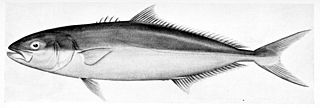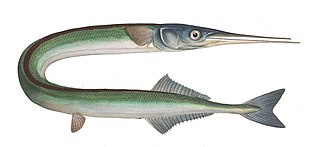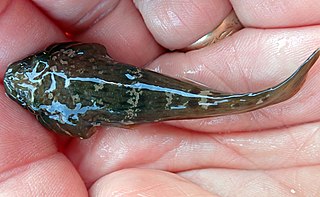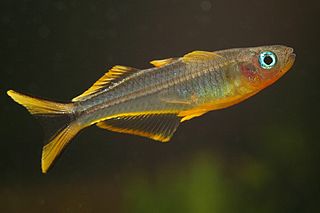
The Carangidae are a family of ray-finned fish which includes the jacks, pompanos, jack mackerels, runners, and scads. It is the largest of the six families included within the order Carangiformes. Some authorities classify it as the only family within that order but molecular and anatomical studies indicate that there is a close relationship between this family and the five former Perciform families which make up the Carangiformes.

The southern yellowtail amberjack, yellowtail kingfish or great amberjack is a large fish found in the Southern Ocean. Although previously thought to be found in all oceans and seas, recent genetic analysis restricts S. lalandi proper to the Southern Hemisphere waters. However, they are found in northern hemisphere waters during certain times of the year. The fish was given its name by Monsieur de Lalande, a naturalist who first informed Valenciennes of the existence of this species. No-one is sure why he used the word Seriola - to name the fish, but the second word Lalandi was derived from his surname Lalande.

The garfish, also known as the garpike or sea needle, is a pelagic, oceanodromous needlefish found in brackish and marine waters of the Atlantic Ocean, the Pacific Ocean and the Mediterranean, Caribbean, Black, and Baltic Seas.

Pompanos are marine fishes in the genus Trachinotus in the family Carangidae. Pompano may also refer to various other, similarly shaped members of the Carangidae, or the order Perciformes. Their appearance is deep-bodied, toothless, with a forked tail and narrow base. They are typically overall silvery in color, sometimes with dark or yellowish fins, and one or a few black markings on the side of their body. They are relatively large fish, up to about 1.2 m (3.9 ft) long, although most species reach no more than half or two-thirds of that size. They are found worldwide in warmer seas, sometimes also entering brackish waters.

Anthias are members of the family Serranidae and make up the subfamily Anthiinae. Anthias make up a sizeable portion of the population of pink, orange, and yellow reef fishes seen swarming in most coral reef photography and film. The name Anthiidae is preoccupied by a subfamily of ground beetles in the family Carabidae created by Bonelli in 1813 and this grouping should be called the Anthiadinae. However, both the 5th Edition of Fishes of the World and Fishbase give the Serranid subfamily as "Anthiinae".

The leatherjacket fish or leather jack, Oligoplites saurus, is a species of jack in the family Carangidae. Leather jack may also refer to other members of the Carangidae, such as the pilot fish. The largest are about a foot long.

The New Zealand lumpfish is a clingfish of the family Gobiesocidae, found all around New Zealand including the Three Kings Islands, from low water to about 12 m, on rocky coastlines. Its length is up to 10 cm. This species was described as Lepadogaster pinnulatus by Johann Reinhold Forster in 1801 with a type locality of Queen Charlotte Sound, Marlborough Sounds off the South Island of New Zealand.

The yellow-edged lyretail also known as the yellowedge coronation trout , fairy cod, lunar tail rock cod, lunartailed cod, lyre-tail cod or moontail seabass,, is a species of marine ray-finned fish, a grouper from the subfamily Epinephelinae which is part of the family Serranidae, which also includes the anthias and sea basses. It is found in the Indo-Pacific region is commoner than the congeneric white-edged lyretail.

The Hawaiian grouper, also known as the Hawaiian black grouper, Seale's grouper or Hapuʻupuʻu, is a species of marine ray-finned fish, a grouper from the subfamily Epinephelinae which is part of the family Serranidae, which also includes the anthias and sea basses. It is endemic to Hawaii.

Zaniolepis is a genus of scorpaeniform fish native to the eastern Pacific Ocean. Z. frenata is known to have been a source of food to the Native American inhabitants of San Nicolas Island off the coast of southern California, United States during the Middle Holocene.

The Pseudomugilidae, the blue-eyes, are a subfamily of atheriniform fish in the Melanotaeniidae, related to the rainbowfishes. They inhabit fresh and brackish water in Australia, New Guinea and nearby smaller islands. Blue-eyes are small fish, typically no more than 5 cm (2.0 in) in length. Like rainbowfish, they spawn all year round, and attach their eggs to vegetation.

Enneapterygius tutuilae, known commonly as the high-hat triplefin or rosy cheek threefin, is a species of triplefin blenny in the genus Enneapterygius. It was described by David Starr Jordan and Alvin Seale in 1906. This species occurs from the eastern Indian Ocean around the Cocos (Keeling) Islands east to French Polynesia. Its specific name refers to the Samoan island of Tutuila where the type was collected.

Norfolkia squamiceps, known commonly as the Scalyhead triplefin, is a species of triplefin blenny in the genus Norfolkia. It was described by Allan Riverstone McCulloch and Edgar Ravenswood Waite in 1916. Under the synonym Norfolkia lairdi it was the type species of Fowler's new genus. This species has been recorded from off Queensland, Norfolk Island, Lord Howe Island, New Caledonia and the Loyalty Islands. The adults occur in tidal pools among areas of coral reef.

The ornate rainbowfish is a species of rainbowfish endemic to an area in eastern Australia, where it is native to coastal regions and sandy offshore islands in southern Queensland and northern New South Wales. It is the only known member of its genus. It is a popular aquarium fish.

Epinephelus labriformis, commonly called starry grouper or flag cabrilla is a species of marine ray-finned fish, a grouper from the subfamily Epinephelinae which is part of the family Serranidae, which also includes the anthias and sea basses. It is found in the eastern Pacific Occean.

Paranthias is a genus of marine ray-finned fish, groupers from the subfamily Epinephelinae, part of the family Serranidae, which also includes the anthias and sea basses. They are found in the Atlantic Ocean and the eastern Pacific Ocean.

The masked grouper, also known as the thinspine grouper, rededged cod, red-edged grouper, slenderspine grouper, thinspine rockcod, white-margined grouper, white-square cod or white-square grouper, is a species of marine ray-finned fish, a grouper from the subfamily Epinephelinae which is part of the family Serranidae, which also includes the anthias and sea basses. It is found in the western Atlantic Ocean. It is the only species in the genus Gracila.

Diplecogaster bimaculata, the two-spotted clingfish, is a species of fish in the family Gobiesocidae found in Black Sea, Mediterranean Sea and Atlantic Ocean where it is found on rocks and among seagrass or shell beds.
The ocellate soapfish is a species of marine ray-finned fish with a wide Indo-Pacific distribution. It is the only species in the genus Grammistops. It is also known as the ocellated soapfish, ocellated podge, or false-eyed soapfish. The specific name ocellatus refers to the ocellate (eye-like) spot on the operculum.

















